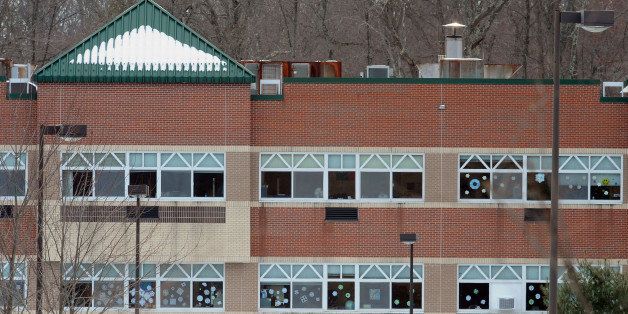
My youngest son, Lindell, doesn't know what happened at Sandy Hook Elementary school on December 14, 2012. He had just started kindergarten and was nearly the age of the victims, so I shielded him from the news. Call it maternal editing. Call it over-protection. But even I couldn't wrap my head around what had happened; how would he?
I never expected that one day we would wind up in front of the new Sandy Hook Elementary school, or how I'd struggle to explain it then.
About a year ago, I heard that the entire town of Monroe, Conn., was reading my book Dinner with the Smileys as part of a "One Book, One Town" event. Monroe invited us to their city so that we could do presentations at the schools and speak to the citizens. That happened last month, over Veterans Day.
Prior to our trip, I researched the area in order to prepare my talks. That's when I found out that Monroe neighbors Sandy Hook, that the children who were in Sandy Hook Elementary School that day now attend school in a building located in Monroe. In the wake of the massacre, Monroe's leaders generously reached out to the Newtown School District, of which Sandy Hook is a part, offering a vacant school building on their campus.
I was immediately overcome with emotion remembering that day. I walked away from my computer and cried again over the children who never came home and threw their backpacks on the kitchen floor. I thought about their parents, wondering how they ever went on.
And then I realized I would have to talk to Lindell about what had happened before we went to Monroe. Except, every time I tried, the words wouldn't come out. I'd look at Lindell's big, brown eyes and feel completely frozen.
Lindell knows about 9/11, and he's overheard things about wars, so he's not completely sheltered. But for some reason, I could not look at his face and explain to him what happened at Sandy Hook, which locals refer to as "12/14" to separate the event from the place.
What happened on 12/14 makes no sense to me; how could I make sense of it for Lindell? Also, Lindell knows what it's like to sit in a classroom, listen to a teacher and daydream about going home. If I told him what had happened, he'd absolutely identify with the children. Can a 7-year-old handle that?
The people of Monroe warned us about the police checkpoints we'd go through to get to one of their schools that shares a campus with the new Sandy Hook building. Nearly two years later, the school still receives threats and requires a constant police presence. I knew this would bring questions from Lindell. Still, I couldn't get out the answer.
Finally, I managed this: I told Lindell that a very bad thing happened at the original Sandy Hook Elementary School. A man broke in.
"But couldn't they just fix the windows?" he asked.
"The man broke in while the kids were there," I said fumbling over my words.
"And so they tore it down? I don't understand."
"The man killed himself in front of the children," I said. This isn't entirely true. There were no students alive to see the man kill himself, but it was the best explanation I could manage.
Lindell looked more confused, so I stopped talking. Maybe that was all he could handle right now.
My husband and I, of course, still talked to all our boys -- the older two know what happened on 12/14 -- about how the people of Sandy Hook had been through a bad time and needed comfort, kindness and support. Monroe, their neighbors, had stepped up and offered them a school building and, hopefully, some normalcy.
This my boys understood. It's what Dinner with the Smileys was all about: a community of people helping each other. And I marveled as my children rose to the occasion. When students gave them friendship necklaces, my boys, who generally don't wear necklaces, graciously wore them -- all day. They gave high fives and listened to the students' stories. All of them -- my kids and Monroe's kids -- were encouraging and kind.
This is the town that gave Sandy Hook Elementary a home again. A town that accepted the guarded, police-filled presence in order to help their neighbors.
On the way home, my boys talked about how welcoming Monroe was. They mentioned the children's friendliness and how all the schools felt like home. They were impressed by the overwhelming sense of community that was evident everywhere, from the library to the high school to the local grill where we had lunch.
Lindell talks often about Sandy Hook since returning home. He wants to write letters to the kids. I can tell that he is processing and maybe even deciding whether to ask more questions. But he doesn't.
I realize that some day Lindell will know exactly what happened at Sandy Hook. He will know all the horrible facts and feel just as confused, angry and sad as the rest of us. But today, all Lindell knows about Sandy Hook is that it is a town that got through something horrible by coming together as a community. And for now, maybe that's enough.